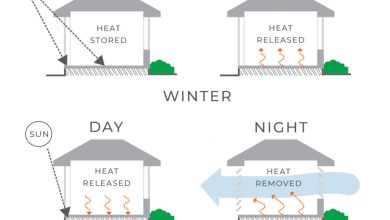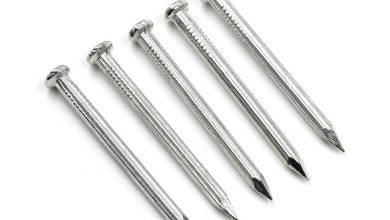What Is a Soft Joint in Masonry
A soft joint, also known as a control joint, is a grout line filled with colored silicone or caulk instead of grout.
It is used in masonry to allow for movement in tile installations without cracking tiles or grout.
Control joints are necessary for large tile installations, and they should be placed every 20-25 feet for interior installations and every 8-12 feet for exterior installations.
Lack of control joints and proper perimeter spacing can lead to cracked grout and tiles, causing the installation to fail.
Did You Know?
1. A soft joint in masonry refers to a flexible connection between two adjacent brick or stone units that allows for movement due to settling or thermal changes.
2. Soft joints are often implemented in masonry structures to prevent cracking or damage that could result from the expansion and contraction of the materials.
3. In some cases, soft joints can be made using compressible materials such as cork or foam rubber, which absorb movement between the masonry units.
4. Soft joints can also be constructed with precompressed materials known as joint fillers, which are designed to expand and create a seal when compressed between two masonry units.
5. While soft joints are commonly found in buildings, they are also utilized in various infrastructure projects such as bridges or tunnels to withstand the dynamic forces affecting the structure over time.
What Is A Soft Joint In Masonry?
A soft joint, also referred to as a control joint, is a grout line that is filled with colored silicone or caulk instead of grout. It acts as a flexible buffer, allowing for movement in tile installations without risking cracks in the tiles or grout. By accommodating the natural expansion and contraction of the materials, control joints play a vital role in maintaining the stability and longevity of the masonry. Such joints are especially critical in large tile installations, as failing to include them can often result in tile installation failure.
Importance Of Control Joints In Tile Installations
Control joints significantly contribute to the durability of tile installations by preventing cracks caused by movement and temperature changes. The absence of control joints is a leading cause of tile installation failure. The lack of flexibility in the grout lines can cause the tiles to crack and the grout to become dislodged as the masonry expands or contracts.
To address this issue, strategically placed control joints create spaces where movement can occur. These joints act as relief points, allowing for necessary expansion and contraction without compromising the installation’s integrity. By incorporating control joints, masons ensure that the tiles remain intact, the grout remains stable, and the overall stability of the structure is preserved.
- Control joints prevent cracks in grout and tiles caused by movement and temperature changes.
- Lack of control joints is a leading cause of tile installation failure.
- Control joints allow for necessary expansion and contraction without compromising installation integrity.
- Incorporating control joints ensures tile and grout stability and preserves the overall structure’s stability.
Guidelines For Installing Control Joints In Interior And Exterior Installations
To achieve optimal stability and prevent tile installation failure, it is crucial to follow guidelines regarding the placement of control joints.
- For interior installations, the Tile Council of North America (TCNA) recommends incorporating a control joint every 20-25 feet.
- However, in exterior installations, where exposure to direct sunlight and varying weather conditions can exert additional stress, control joints should be placed approximately every 8-12 feet.
It is important to note that control joints should be installed above expansion joints in concrete. This ensures that movement in the concrete is separate from the movement in the masonry, preventing any potential transfer of stress or cracking.
- When necessary, a membrane can be used to shift the control joint in the tile up to six inches, further enhancing its effectiveness in accommodating movement and preventing damage.
Proper Perimeter Spacing To Allow For Expansion
In addition to placing control joints at regular intervals, proper perimeter spacing is critical to allow for expansion and movement. Without adequate allowance for movement, grout and tiles may crack, jeopardizing the stability of the installation. It is essential to provide enough space for the tile assembly to expand or contract without causing damage.
By following recommended guidelines and ensuring proper perimeter spacing, masons can minimize the risk of cracks and failures in the installation. Taking these necessary precautions not only enhances the aesthetic quality of the masonry but also contributes to its long-term stability and durability.
Next Post: How To Prepare And Install Caulk Or Silicone In A Soft Joint
In the next post, we will explore the process of preparing the grout line as a soft joint and installing the caulk or silicone. This step-by-step guide will provide detailed instructions on how to effectively create and fill control joints using colored silicone or caulk. By understanding the proper technique and following the recommended procedures, masons can ensure that their control joints are correctly installed, contributing to the overall stability and longevity of the masonry.
Check this out:
Frequently Asked Questions
What is a soft joint?
A soft joint refers to a connection that incorporates components capable of easy compression, resulting in delayed fastener yield and a significantly greater angle. This joint design usually involves the use of metallic parts coupled with a gasket or spring washer positioned between them. By allowing for greater flexibility in the connection, a soft joint enables better absorption of shocks and vibrations, minimizing structural stress and promoting overall durability.
What is soft joint and hard joint?
A hard joint refers to a type of joint that does not incorporate any washer, rubber gasket, or any tightening in a material such as MS (mild steel). These joints do not require a high compression force and are typically straightforward in their construction. On the other hand, soft joints are specifically designed to include rubber gaskets, spring washers, and tightening in materials such as aluminum or plastic. These joints are created to provide a more flexible and adaptable connection, often requiring specific compression forces for proper functioning.
What are soft joints in tile?
Soft joints in tile are specifically designed to accommodate movement within the tile floor. These joints act as interruptions in the surface, creating gaps or spaces next to tiles that allow for slight movement. Soft joints are crucial in tile installation as they prevent stress on the tiles and protect against potential cracking or damage. They can be either expansion joints, which allow for movement within the tile field, or perimeter joints, which provide space for movement along the edges of the tile installation. By incorporating soft joints, tile floors are able to adapt to the natural expansion and contraction that may occur due to temperature changes or structural shifting, ensuring the longevity and durability of the installation.
What is a joint in masonry?
In masonry, a joint refers to the spaces between bricks, concrete blocks, or glass blocks that are filled with mortar or grout. These joints play a vital role in the overall appearance of the masonry, especially when the surface remains unplastered. The quality and craftsmanship of these joints can greatly enhance the aesthetic appeal of the structure, making them an essential element in masonry construction.

